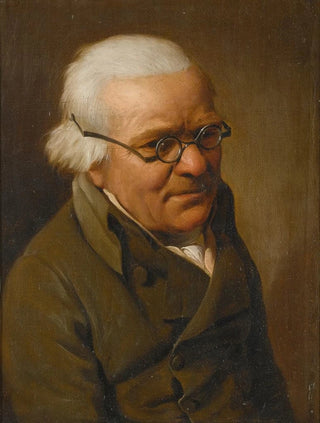Art print | Portrait of a man with white hair half-length wearing glasses - Louis Léopold Boilly


View from behind

Frame (optional)
Louis Léopold Boilly's "Portrait of a man with white hair mid-body wearing glasses" is a work that transcends the simple frame of a portrait to offer a fascinating glimpse into the spirit and aesthetics of the 18th century. This painting, rich in detail and nuance, evokes not only the physical appearance of its subject but also an atmosphere imbued with reflection and wisdom. The man, whose piercing gaze is accentuated by delicate glasses, seems to invite the viewer into a silent conversation, an exchange of ideas that still resonates today. Boilly's technical mastery and keen sense of character psychology make this portrait an essential work, both for art enthusiasts and those interested in the history of human representation.
Style and uniqueness of the work
Boilly, recognized for his talent in capturing the subtleties of human expression, deploys here a palette of soft colors and subtle lighting that envelop the character with a particular aura. The choice to depict this man mid-body, a format that highlights facial details and attire, demonstrates a desire to create an intimate connection between the subject and the viewer. The glasses, as a distinctive element, add a dimension of modernity and sophistication to this art print, while emphasizing the man's intellectual curiosity. The precision of the features, the finesse of the textures, and the harmony of colors reveal not only Boilly's craftsmanship but also his innovative approach to portrait art, where each element contributes to the overall composition.
The artist and his influence
Louis Léopold Boilly, born in 1761, is an emblematic figure of French painting, whose work sits at the crossroads between Neoclassicism and Romanticism. His career, marked by a constant exploration of everyday life themes and portraits, influenced many artists of his time and subsequent generations. Boilly was able to capture the very essence of his era, reflecting the social and cultural changes that marked France at the end of the 18th century and

Matte finish

View from behind

Frame (optional)
Louis Léopold Boilly's "Portrait of a man with white hair mid-body wearing glasses" is a work that transcends the simple frame of a portrait to offer a fascinating glimpse into the spirit and aesthetics of the 18th century. This painting, rich in detail and nuance, evokes not only the physical appearance of its subject but also an atmosphere imbued with reflection and wisdom. The man, whose piercing gaze is accentuated by delicate glasses, seems to invite the viewer into a silent conversation, an exchange of ideas that still resonates today. Boilly's technical mastery and keen sense of character psychology make this portrait an essential work, both for art enthusiasts and those interested in the history of human representation.
Style and uniqueness of the work
Boilly, recognized for his talent in capturing the subtleties of human expression, deploys here a palette of soft colors and subtle lighting that envelop the character with a particular aura. The choice to depict this man mid-body, a format that highlights facial details and attire, demonstrates a desire to create an intimate connection between the subject and the viewer. The glasses, as a distinctive element, add a dimension of modernity and sophistication to this art print, while emphasizing the man's intellectual curiosity. The precision of the features, the finesse of the textures, and the harmony of colors reveal not only Boilly's craftsmanship but also his innovative approach to portrait art, where each element contributes to the overall composition.
The artist and his influence
Louis Léopold Boilly, born in 1761, is an emblematic figure of French painting, whose work sits at the crossroads between Neoclassicism and Romanticism. His career, marked by a constant exploration of everyday life themes and portraits, influenced many artists of his time and subsequent generations. Boilly was able to capture the very essence of his era, reflecting the social and cultural changes that marked France at the end of the 18th century and






